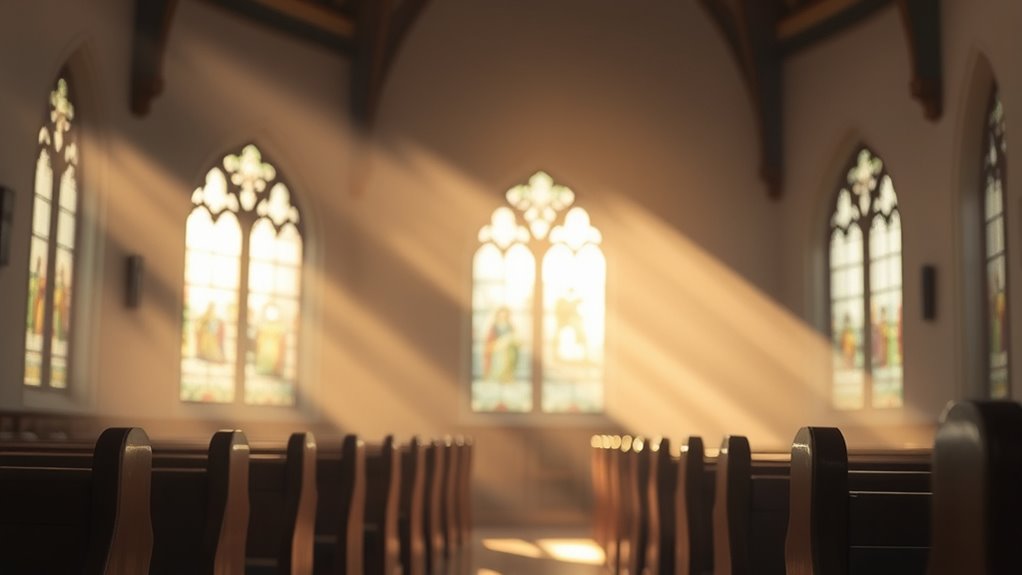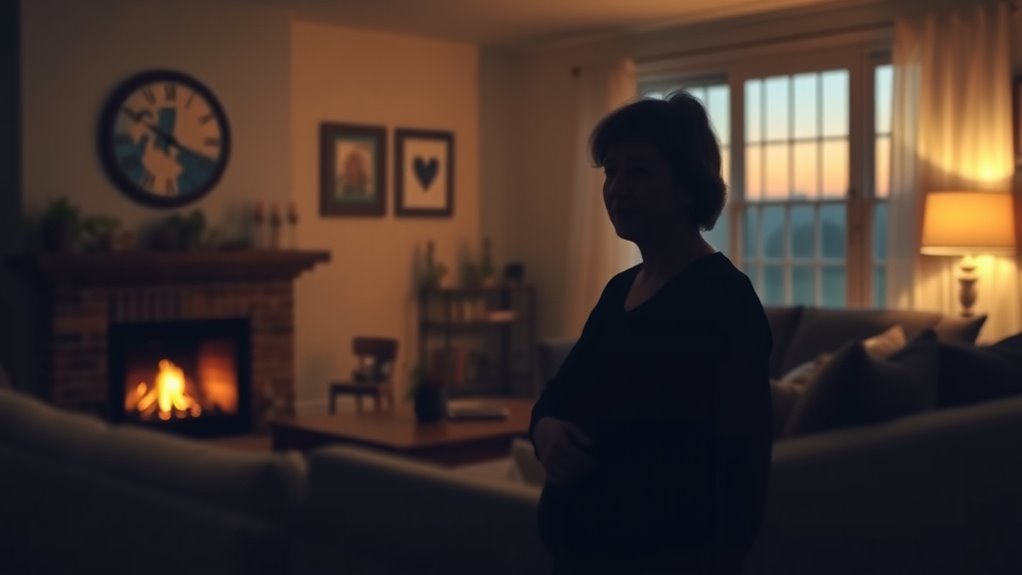Many believe loved ones can communicate after death through signs, dreams, and spiritual rituals rooted in various cultures and religions. These messages might appear as recurring symbols, feelings, or dreams, offering comfort and ongoing connection. While scientific evidence is limited, personal experiences and traditions often support the idea that spirits can reach out in meaningful ways. If you want to explore how these connections happen, there’s more to discover beyond this overview.
Key Takeaways
- Many cultures and spiritual traditions believe communication with deceased loved ones is possible through signs, dreams, or rituals.
- Signs like recurring numbers, symbols, or feelings are often seen as messages from the afterlife.
- Personal experiences such as hearing sounds or sensing presence may indicate ongoing connection.
- Techniques like meditation, prayer, or mediumship are used by some to facilitate communication with the dead.
- Scientific evidence for post-death communication remains unproven, and interpretations often rely on faith or personal belief.
Historical Beliefs and Cultural Perspectives

Throughout history, many cultures have believed that communication with loved ones after death is possible through spiritual or supernatural means. Ancestor reverence plays a vital role in these beliefs, emphasizing respect and ongoing connection with the deceased. In many societies, afterlife rituals serve as a bridge between the living and the dead, enabling communication beyond physical existence. These rituals, such as offerings, prayers, or ceremonies, are designed to honor ancestors and invite their spirits to remain present in daily life. Cultures like the Chinese with their Qingming Festival or the Mexicans during Día de los Muertos exemplify how rituals foster ongoing relationships with loved ones after death. Such practices reflect a universal desire to maintain bonds, believing that spirits can still influence or communicate with the living. These beliefs are often supported by spiritual communication tools, which have gained popularity as modern methods to facilitate connection with the deceased. These practices highlight the importance of cultural rituals in maintaining spiritual connections across generations. Additionally, the belief systems underpinning these practices often emphasize the ongoing presence of spirits and their influence on the living. The social significance of these customs demonstrates how deeply rooted the hope for post-mortem communication is across different societies.
Signs and Symbols From Beyond

Many people believe that signs and symbols from beyond can serve as messages from loved ones who have passed away. These spiritual signs often appear unexpectedly, providing comfort or guidance. After death communication through signs can include seeing recurring numbers, finding feathers, or noticing certain animals or objects that seem significant. You might find a specific song playing when you’re thinking of them or notice synchronicities that feel meaningful. Recognizing these signs requires awareness and an open mind. While not everyone experiences them, many trust that these spiritual signs are a gentle form of connection, affirming that love transcends physical death and continues on a different plane. Paying attention to recurring number patterns can enhance your ability to interpret these messages more accurately. Understanding signs and symbols from beyond can help you interpret these meaningful messages more effectively, especially when you learn to interpret spiritual symbolism as a language of the unseen. Developing intuitive perception can further deepen your understanding of these subtle messages from the spiritual realm.
The Role of Dreams in Communication

Have you ever wondered if dreams can serve as a way for loved ones to communicate from beyond? Many believe that dreams carry deep symbolism, acting as a form of subconscious messaging. When you dream of someone who has passed, the symbols or scenarios may reflect their desire to reach out or offer comfort. These dream symbols often carry personal meaning, making it easier for you to interpret their message. Your subconscious processes emotional connections, allowing loved ones to bypass physical boundaries. While not everyone experiences clear messages, some find that dreams provide a meaningful link, revealing feelings, guidance, or reassurance. The emotional connection between individuals can enhance these dream interactions, making them feel more authentic and profound. Additionally, understanding the psychological processes involved in dreaming can help explain how these messages are received and interpreted. For example, dream symbolism often reflects personal feelings or unresolved issues, which can deepen the significance of such encounters. Recognizing the dreaming process as a natural part of sleep can also help individuals interpret these experiences with greater clarity. Moreover, recent research in AI Security highlights how complex subconscious processes can be, illustrating that dreams are a multifaceted phenomenon. Ultimately, dreams may serve as a private, emotional channel where communication with those who have passed can occur beyond waking awareness.
Spiritual and Religious Interpretations

Spiritual and religious beliefs often shape how people interpret communication with loved ones after death. Many see signs or messages as part of their faith’s afterlife rituals or spiritual practices. These traditions offer comfort and a sense of ongoing connection. You might believe that loved ones communicate through dreams, symbols, or feelings rooted in spiritual rituals. Some religions teach that spirits visit during specific ceremonies or prayer sessions. Others see ongoing communication as evidence of a soul’s journey beyond this life. These interpretations can vary widely but often serve to strengthen faith and provide solace. Embracing these beliefs can help you find reassurance that loved ones remain part of your spiritual world. Cultural beliefs also influence how individuals perceive post-death communication, shaping personal and communal responses to these experiences. Additionally, many traditions emphasize spiritual communication as a way to maintain bonds with the deceased, reinforcing the idea that connection transcends physical death.
Scientific Investigations and Skepticism

Is there scientific evidence that supports communication with loved ones after death? Currently, scientific investigations have yet to confirm any direct contact. Researchers explore quantum physics theories suggesting particles might be entangled across dimensions, but these ideas remain speculative and lack empirical support. Neural imaging studies, like fMRI scans, show how brain activity relates to perception and consciousness, but they don’t prove communication beyond death. Skeptics argue that phenomena attributed to spiritual contact can often be explained by psychological factors, such as hallucinations, grief, or cognitive biases. While some experiments hint at intriguing possibilities, no conclusive scientific evidence exists to verify that loved ones can communicate after death. Skepticism remains grounded in the absence of measurable, reproducible data.
Personal Experiences and Testimonies

Many people who have experienced the loss of a loved one report personal encounters that they interpret as signs of ongoing connection. These experiences often feel deeply meaningful and personal, offering comfort and reassurance. You might recall dream encounters where a loved one appears, providing guidance or reassurance. Others experience ancestral messages, feeling a subtle connection to family history or traditions. Some common signs include:
- Dream encounters that feel vivid and real
- Finding symbolic objects that seem meaningful
- Hearing unexpected sounds or voices
- Noticing recurring numbers or symbols
- Sensing a presence during quiet moments
These testimonies highlight how personal experiences can strengthen the belief that loved ones continue to communicate beyond death, reinforcing the idea of an ongoing spiritual connection.
Mediumship and Spiritual Mediums

Have you ever wondered how mediums connect with spirits or what techniques they use to relay messages? These practitioners often rely on specific methods to establish a spiritual link and interpret signs from loved ones. Validating these communications can help you trust the process and find comfort in the messages received.
How Mediums Connect Spiritually
Mediums serve as spiritual bridges between the living and the deceased, claiming to access messages from loved ones who have passed on. They often draw on ancient rituals and cultural practices to facilitate these connections. By tuning into spiritual energies, mediums create a space where communication is possible beyond physical death. Their methods can include prayer, meditation, or ritualistic gestures rooted in tradition. These practices help them open channels to the spirit world and interpret messages. Many cultures have long-standing rituals designed to honor and communicate with spirits, which mediums may incorporate into their sessions. The process is deeply personal and varies across different traditions, but the goal remains the same: to bridge the gap between worlds and bring comfort to the living.
- Use of prayer and meditation
- Ritualistic gestures and offerings
- Sensory perception and intuition
- Spirit guides and helpers
- Cultural rituals from around the world
Techniques Used in Mediumship
Mediums employ a variety of techniques to access and relay messages from the spirit world. One common method is interpreting psychic impressions—subtle feelings, images, or sensations that come from spirits. These impressions often appear suddenly and can be vivid or vague, guiding the medium to specific details. Another key technique involves entering trance states, where the medium relaxes deeply to facilitate a heightened connection. During trance, the medium may experience altered awareness, allowing spirits to communicate more freely through them. Some mediums also use tools like pendulums or automatic writing to receive messages. These techniques demand focus and sensitivity, enabling the medium to serve as a clear conduit for spirits seeking to reach their loved ones.
Validating Spirit Communications
Validating spirit communications is essential to guarantee that the messages received are genuine and meaningful. You need to approach these experiences with a critical eye, considering moral implications and ethical considerations to prevent deception or exploitation. To verify authenticity, consider these factors:
- Cross-check details with known facts or shared memories
- Seek confirmation from trusted sources or other mediums
- Be cautious of messages that seem overly vague or sensational
- Respect boundaries and avoid financial exploitation
- Reflect on your motives and emotional state during communication
The Impact of Belief on Emotional Healing

Your beliefs can profoundly influence how you find comfort and hope after loss. When you trust in spiritual connections or an afterlife, it can help you achieve emotional closure. Ultimately, your faith shapes your healing journey and how you cope with grief.
Faith’s Role in Comfort
Have you ever noticed how faith can provide a comforting sense of connection even after someone has passed away? It often offers spiritual reassurance, helping you feel close despite physical separation. Believing in an afterlife communication can ease grief by fostering hope and trust that loved ones remain present in some form. Your faith may encourage you to interpret signs or dreams as messages from beyond, reinforcing your emotional healing.
- Provides a sense of ongoing relationship
- Eases feelings of loneliness
- Reinforces trust in spiritual existence
- Offers hope during difficult times
- Helps process grief with a positive outlook
Hope and Emotional Closure
Believing that communication with loved ones after death is possible can be a powerful source of hope, helping you find emotional closure. This belief can comfort you during grief, providing a sense that your loved ones remain present in some form. Reincarnation theories suggest souls return, offering reassurance that connections persist beyond physical death. Similarly, ancestral reverence emphasizes honoring those who have passed, fostering ongoing spiritual bonds. Embracing these ideas can transform loss into a continued relationship, easing emotional pain. Hope rooted in such beliefs encourages healing, allowing you to cherish memories while feeling a sense of ongoing connection. This emotional closure is essential for moving forward, giving you peace and resilience amid grief.
Beliefs Shaping Healing
The beliefs you hold about life after death can considerably influence how you process grief and find emotional healing. If you believe loved ones continue in some form, it can ease pain and foster hope. Engaging in grief counseling tailored to your beliefs helps you navigate emotions. Participating in funeral rituals offers comfort and a sense of connection. Your perception of an ongoing spiritual existence can promote acceptance and peace. Conversely, viewing death as final might make it harder to heal, but focusing on memories and legacy remains essential. Embracing your beliefs allows you to create meaningful rituals and find closure. Ultimately, your worldview shapes your healing journey, guiding you through grief with purpose and understanding.
Navigating Grief and Maintaining Connection

Guiding grief can feel overwhelming, but finding ways to maintain a connection with your loved one can offer comfort and continuity. Exploring practices like past life regression may help you feel closer, as some believe it reveals reincarnation beliefs that keep souls connected across lifetimes. You might find solace in understanding that death isn’t necessarily the end, and that your loved one’s spirit could return in another form or life. Maintaining rituals, such as memorials or personal touches, helps keep their memory alive. Trusting your intuition and remaining open to subtle signs can also foster ongoing connection. Remember, grief is a personal journey, and finding meaningful ways to stay connected can provide reassurance and peace amidst loss.
Frequently Asked Questions
Can Loved Ones Communicate With Us Through Electronic Devices After Death?
You might wonder if loved ones can communicate through electronic devices after death. Many believe spiritual signs, like sudden feelings or messages, are ways loved ones send clues. Some turn to electronic mediums, hoping to connect beyond physical life. While there’s no scientific proof, these signs can provide comfort and a sense of ongoing connection, making it feel like your loved ones are still nearby in subtle, meaningful ways.
Are There Specific Times When Communication From the Deceased Is More Likely?
Think of spiritual signs as gentle whispers from beyond, often appearing during emotional triggers or quiet moments. You’re more likely to notice these signs during times of deep reflection, grief, or heightened emotion when your mind is open. These moments become like open windows, allowing loved ones’ messages to flow through. While timing varies, trusting your intuition can help you recognize when communication from the other side might be more accessible.
How Can One Differentiate Between Genuine Messages and Imagination?
When trying to tell genuine messages from imagination, trust your intuition and look for signs like clarity or emotional impact. Dream interpretation can reveal meaningful insights, often feeling more real than mere imagination. Psychic phenomena might also provide subtle, authentic messages. Stay open-minded, but skeptical, and notice consistency over time. Genuine messages tend to resonate deeply, whereas imagination feels fleeting or inconsistent. Ultimately, your feelings can guide you in distinguishing between the two.
Do Pets Also Communicate With Us After They Pass Away?
Many believe that pets can communicate with us after they pass away through subtle signs during mourning rituals or moments of reflection. You might notice sudden feelings, smells, or sightings that feel meaningful. These experiences are often seen as pet communication from beyond, providing comfort. Trust your intuition, and consider how these signs resonate within your mourning rituals to find reassurance that your pet’s spirit is still with you.
Can Communication With the Dead Be Scientifically Proven or Measured?
You wonder if communication with the dead can be scientifically proven or measured. While paranormal phenomena suggest such possibilities, scientific skepticism remains high because there’s no concrete, repeatable evidence. Researchers require measurable proof, but claims of contact often lack that. Until science can verify these experiences objectively, communication with the dead stays in the domain of personal belief and anecdotal reports rather than proven scientific fact.
Conclusion
Whether through signs, dreams, or heartfelt memories, your loved ones continue to find ways to whisper beyond the veil. Think of their presence as a gentle breeze, unseen but felt, guiding you through your darkest moments. While science remains cautious, your belief can be a comforting lighthouse in the fog of grief. Keep your heart open; in the quiet moments, their love may still be reaching out, shining like stars in the night sky.









